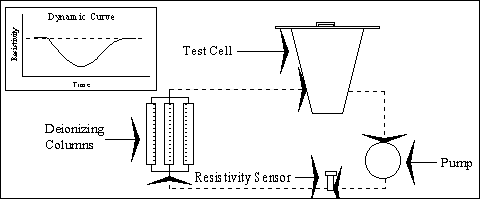Zero-Ion
Ionic Contamination (Cleanliness) Tester
The Most Sensitive Tester Available
 Specifically
cited in MIL-2000A as an approved method of determining the cleanliness
of circuit assemblies (mil equivalency factor of 3.7 micrograms/square),
the Zero Ion is one of the most popular testers available, and is available
from Aqueous Technologies.Today, in an environment where densely populated
surface mount technology has become common place, and where ISO 9000 verifications
are required, the need for ionic testing is essential.Aqueous Technologies'
Zero Ion ionic contamination tester is equipped with the following features
and benefits: Specifically
cited in MIL-2000A as an approved method of determining the cleanliness
of circuit assemblies (mil equivalency factor of 3.7 micrograms/square),
the Zero Ion is one of the most popular testers available, and is available
from Aqueous Technologies.Today, in an environment where densely populated
surface mount technology has become common place, and where ISO 9000 verifications
are required, the need for ionic testing is essential.Aqueous Technologies'
Zero Ion ionic contamination tester is equipped with the following features
and benefits:
The built-In computer automatically calculates NaCl/square equivalence
(per mil spec), operates in an automatic or manual mode, and is equipped
with a built-in memory containing up to 50 test results.

The submerged sprays provide excellent agitation of the test
solution while eliminating test inaccuracies caused by carbon dioxide
adsorption associated with other open-air spray systems. The combination
of submersion and spraying creates three different fluid flow angles across
the board surface. It is this random angle flow of fluid that gives the
Zero Ion system its superiority in ionic contamination detection.
The Zero Ion tester is equipped with a built-in data logging
printer that automatically records test date, lot/batch number and test
results.
The Zero Ion tester utilizes a dynamic measurement method, the method
of choice for detecting (weak) ion activators commonly found in no-clean
fluxes. With dynamic measurement technology, the contamination test solution
is monitored and then filtered to supply de-ionized test solution back
to the test chamber, resulting in greater solubility. The increased solubility
eliminates the "saturation limit effect", associated with other static
measurement methods.

The Zero Ion tester is extremely cost effective.
Its price is among the lowest in the industry, yet its performance is
second to none.
The Zero Ion tester is extremely compact, requiring
only a 2' square footprint, with test cells available for board sizes
up to 24" x 24" (609 mm x 609 mm).
|